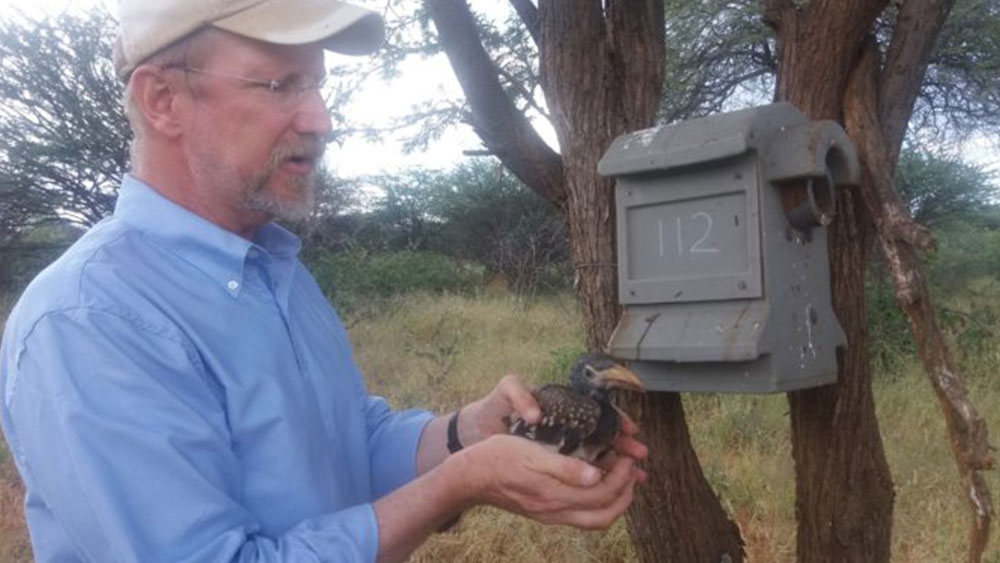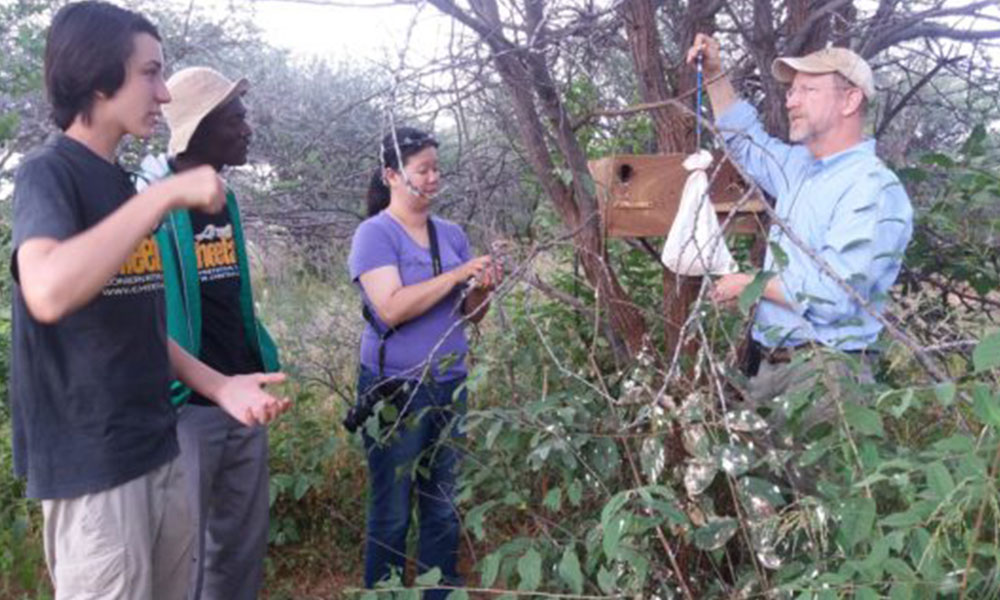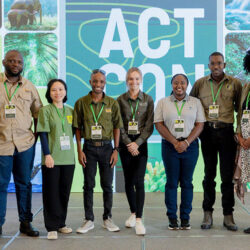Research Project – Hornbills and Cavity Nesters
-

- by Dr. Mark Stanback April 28, 2017

Dr. Mark Stanback | Dept. of Biology | Davidson College | Davidson, NC
Having conducted hornbill research in Namibia over 20 years ago, I have long been keen to get back and continue with field work. Over the last couple of years I have made several trips to Namibia to install nest boxes in anticipation of spending an entire breeding season here in 2017 and again in 2018. I arrived at CCF in early January with several MET research permits and high hopes. In addition to investigating hornbill breeding biology, I am also interested in how the various species of cavity nesters share the limited number of tree cavities/nest boxes that are available to them. In particular, I wanted to better understand how honeybees and birds interact. Moreover, because honey guides can consume beeswax, they are uniquely effective at making abandoned honeybee hives available for cavity-nesting birds.
I was planning an experiment in which I would document how quickly honey guides could discover and consume beeswax (either raw comb or pure wax) placed in empty nest boxes. Unfortunately, the recent southern African drought reduced the number of beehives in the area substantially. This in turn reduced the number of honey guides. Consequently, the wax I placed in boxes remained undiscovered and uneaten for the most part. However, with the excellent rains this season, I am confident that honeybees will return to the area and that the honey guides will follow them. I thus look forward to conducting my experiment in 2018.

With respect to the hornbills, I am interested in understanding how female hornbills allocate energy to eggs. The breeding biology of hornbills is unusual in many ways, all revolving around the fact that the female seals herself inside her nest cavity and remains inside for the entire egg-laying and incubation periods. It is only when the chicks are half grown that the female emerges. Hornbill females are highly variable in the number of eggs they lay, the size of the eggs they lay, and the speed at which they produce eggs. I would like to know how much of this variation is due to the energy reserves with which a female enters the nest cavity. Specifically, is a female producing eggs with her own capital, or is she making eggs with the income provided by the male once she is sealed inside? This year I was able to examine egg production among the females of three different hornbills species (Damara, yellow-billed, and Monteiro’s).
A final question we addressed this year concerned how nestlings allocate their energy toward growth. Some seem to turn food into mass, while others prioritize feather production. Moreover, I want to know if sex or size rank influcences how nestlings prioritize growth during their long imprisonment inside the nest cavity.
Throughout all of this data collection, I was assisted by two excellent young Nambians. Image Katangu was an intern at CCF who had an interest in birds. He was recruited by my student and collaborator, David Millican, to help both of us with our field work (on top of his other duties as a CCF intern). Though he was only able to work with David and myself for a couple weeks, I was very impressed by his interest and enthusiasm. Martha Alfeus was another valued Namibian collaborator. Although Martha was not an intern, she was working at CCF identifying hair remains in predator scat in order to better understand the diet of large carnivores. Martha ended up working full time with us (thanks to a collaboration between CCF, the MET, and UNAM). Martha split her time between spending time in the field with me checking nest boxes and with David doing point counts and searching for bird nests in natural tree cavities. Martha was not put off by the routine of early morning bird work, the wet feet that stayed wet all day, the thorns, the heat, or the bird poop. She was a fast learner and was eager to learn more about cavity-nesting birds.
In fact, I was continually impressed by all of the CCF interns. They worked long days, they had to master a variety of tasks, and the quality of their work was constantly scrutinized. They were serious about their work and friendly at all times. Although I didn’t get to know all of them (I spent most of my time in the bush away from the center), I think their youth and enthusiasm helps make CCF the exciting place it is.
Related Reading
-
August 27, 2025
Sniffing Out Stories with the Scat Detection Dog Team




